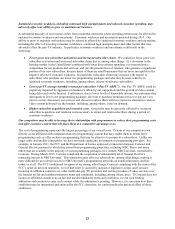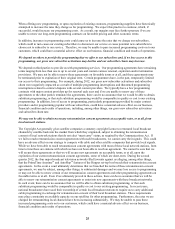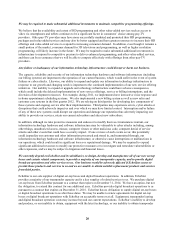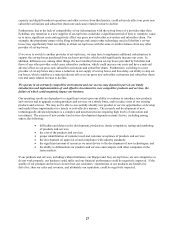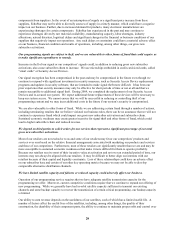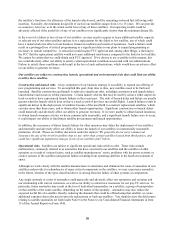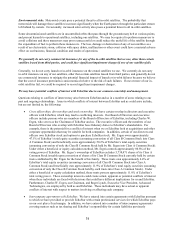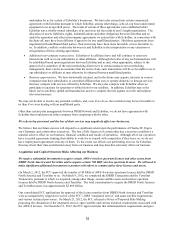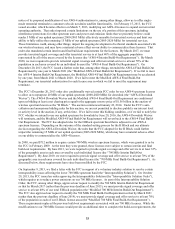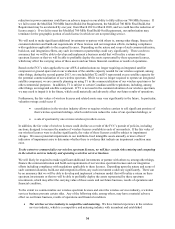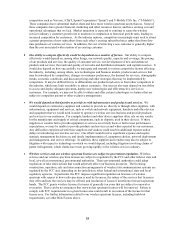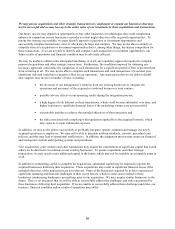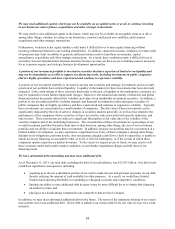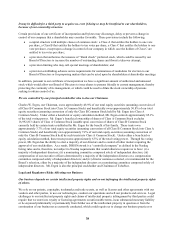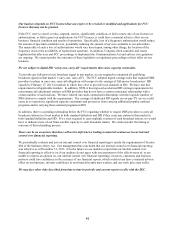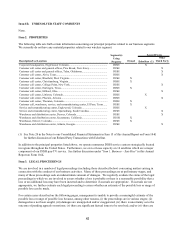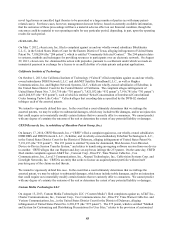Dish Network 2013 Annual Report Download - page 43
Download and view the complete annual report
Please find page 43 of the 2013 Dish Network annual report below. You can navigate through the pages in the report by either clicking on the pages listed below, or by using the keyword search tool below to find specific information within the annual report.33
33
notice of its proposed modification of our AWS-4 authorizations to, among other things, allow us to offer single-
mode terrestrial terminals to customers who do not desire satellite functionality. On February 15, 2013, the FCC
issued an order, which became effective on March 7, 2013, modifying our AWS-4 licenses to expand our terrestrial
operating authority. That order imposed certain limitations on the use of a portion of this spectrum, including
interference protections for other spectrum users and power and emission limits that we presently believe could
render 5 MHz of our uplink spectrum (2000-2005 MHz) effectively unusable for terrestrial services and limit our
ability to fully utilize the remaining 15 MHz of our uplink spectrum (2005-2020 MHz) for terrestrial services.
These limitations could, among other things, impact the ongoing development of technical standards associated with
our wireless business, and may have a material adverse effect on our ability to commercialize these licenses. That
order also mandated certain interim and final build-out requirements for the licenses. By March 2017, we must
provide terrestrial signal coverage and offer terrestrial service to at least 40% of the aggregate population
represented by all of the areas covered by the licenses (the “AWS-4 Interim Build-Out Requirement”). By March
2020, we were required to provide terrestrial signal coverage and offer terrestrial service to at least 70% of the
population in each area covered by an individual license (the “AWS-4 Final Build-Out Requirement”). On
December 20, 2013, the FCC issued a further order that, among other things, extended the AWS-4 Final Build-Out
Requirement by one year to March 2021 (the “Modified AWS-4 Final Build-Out Requirement”). If we fail to meet
the AWS-4 Interim Build-Out Requirement, the Modified AWS-4 Final Build-Out Requirement may be accelerated
by one year, from March 2021 to March 2020. If we fail to meet the Modified AWS-4 Final Build-Out
Requirement, our terrestrial authorization for each license area in which we fail to meet the requirement may
terminate.
The FCC’s December 20, 2013 order also conditionally waived certain FCC rules for our AWS-4 spectrum licenses
to allow us to repurpose 20 MHz of our uplink spectrum (2000-2020 MHz) for downlink (the “AWS-4 Downlink
Waiver”). The AWS-4 Downlink Waiver and the Modified AWS-4 Final Build-Out Requirement are conditioned
upon us bidding at least a net clearing price equal to the aggregate reserve price of $1.56 billion in the auction of
wireless spectrum known as the “H Block.” The auction commenced January 22, 2014. Under the FCC’s anti-
collusion and anonymous bidding rules for this auction, we are not permitted to disclose publicly our interest level
or activity level in the auction, if any, at this time. If we fail to meet this bidding condition, or if we fail to notify the
FCC whether we intend to use our uplink spectrum for downlink by June 20, 2016, the AWS-4 Downlink Waiver
will terminate, and the Modified AWS-4 Final Build-Out Requirement will revert back to the AWS-4 Final Build-
Out Requirement. The FCC has adopted rules for the H Block spectrum band that is adjacent to our AWS-4
spectrum licenses. Depending on the outcome of the standard-setting process for the H Block and our ultimate
decision regarding the AWS-4 Downlink Waiver, the rules that the FCC adopted for the H Block could further
impact the remaining 15 MHz of our uplink spectrum (2005-2020 MHz), which may have a material adverse effect
on our ability to commercialize the AWS-4 licenses.
In 2008, we paid $712 million to acquire certain 700 MHz wireless spectrum licenses, which were granted to us by
the FCC in February 2009. At the time they were granted, these licenses were subject to certain interim and final
build-out requirements. By June 2013, we were required to provide signal coverage and offer service to at least 35%
of the geographic area in each area covered by each individual license (the “700 MHz Interim Build-Out
Requirement”). By June 2019, we were required to provide signal coverage and offer service to at least 70% of the
geographic area in each area covered by each individual license (the “700 MHz Final Build-Out Requirement”). As
discussed below, these requirements have since been modified by the FCC.
On September 9, 2013, we filed a letter with the FCC in support of a voluntary industry solution to resolve certain
interoperability issues affecting the lower 700 MHz spectrum band (the “Interoperability Solution”). On October
29, 2013, the FCC issued an order approving the Interoperability Solution (the “Interoperability Solution Order”),
which requires us to reduce power emissions on our 700 MHz licenses. As part of the Interoperability Solution
Order, the FCC, among other things, approved our request to modify the 700 MHz Interim Build-Out Requirement
so that by March 2017 (rather than the previous deadline of June 2013), we must provide signal coverage and offer
service to at least 40% of our total E Block population (the “Modified 700 MHz Interim Build-Out Requirement”).
The FCC also approved our request to modify the 700 MHz Final Build-Out Requirement so that by March 2021
(rather than the previous deadline of June 2019), we must provide signal coverage and offer service to at least 70%
of the population in each of our E Block license areas (the “Modified 700 MHz Final Build-Out Requirement”).
These requirements replaced the previous build-out requirements associated with our 700 MHz licenses. While the
modifications to our 700 MHz licenses would provide us additional time to complete the build-out requirements, the


